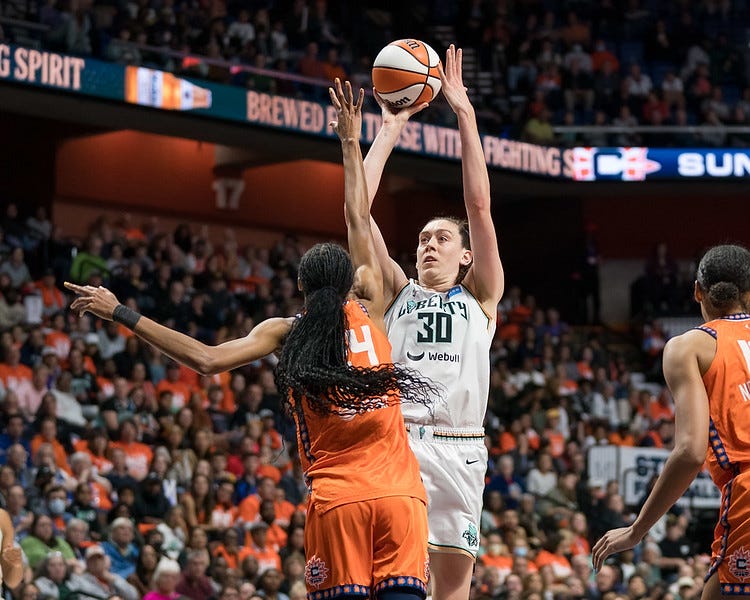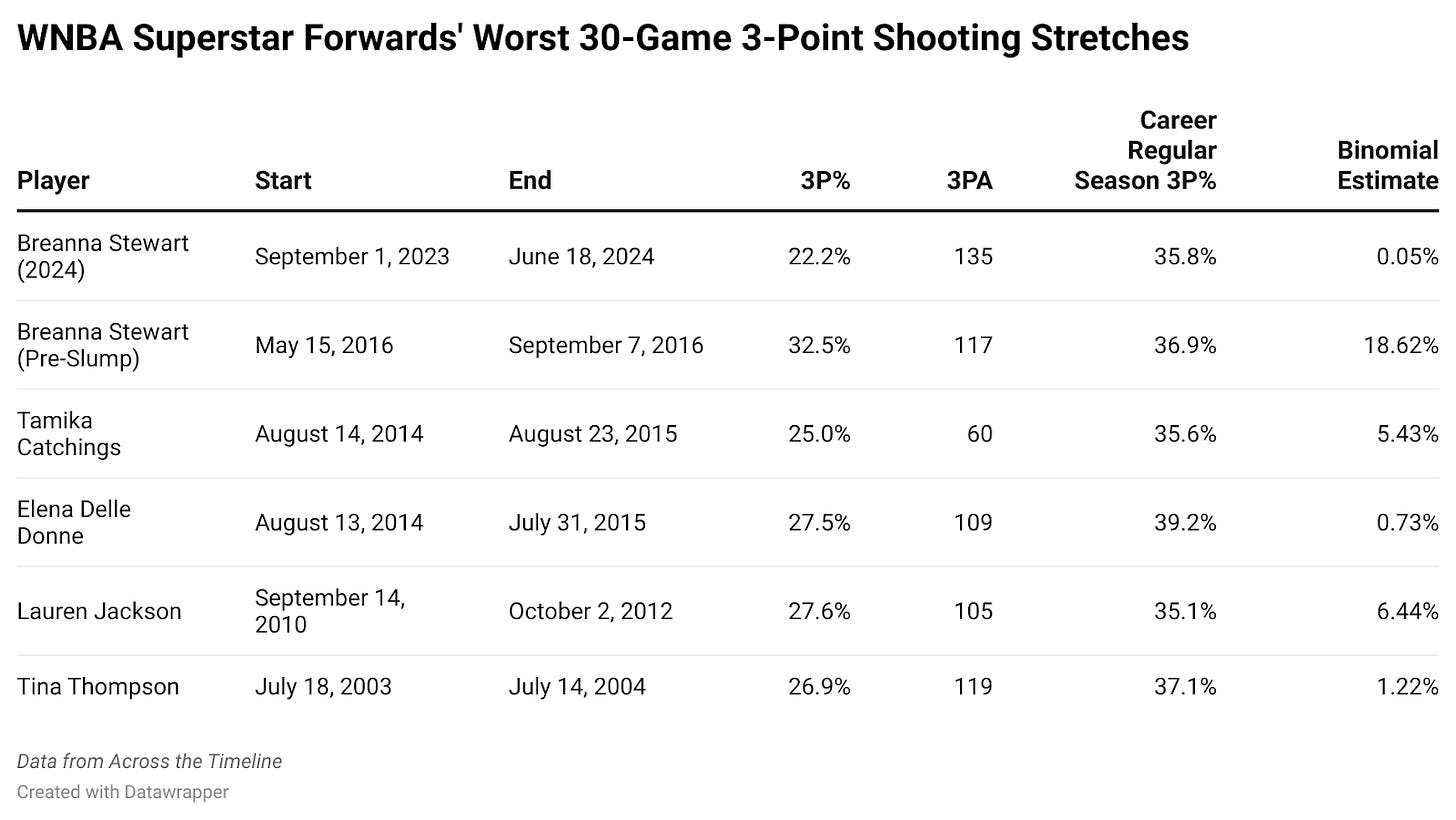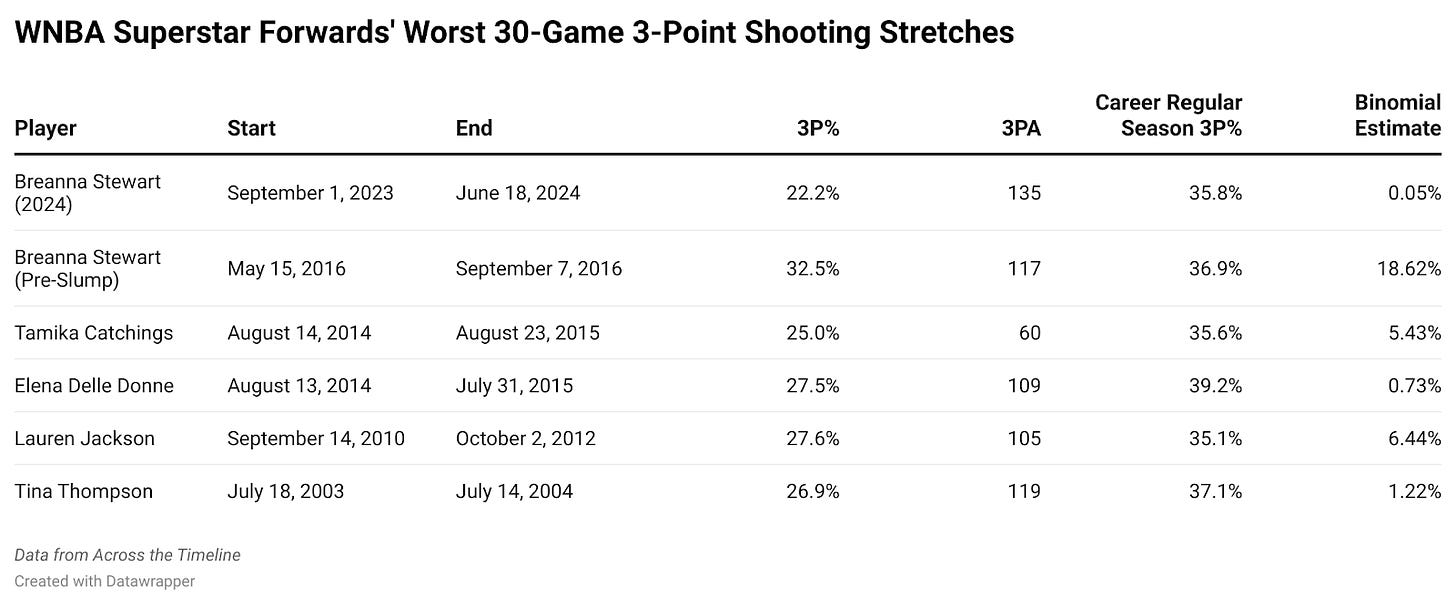Breanna Stewart's Shooting Slump
Analyzing Breanna Stewart's cold stretch from 3-point range and trying to identify possible causes
Thanks for reading the Her Hoop Stats Newsletter. If you like our work, be sure to check out our stats site, our podcast, and our social media accounts on Twitter, YouTube, Facebook, and Instagram. You can also buy Her Hoop Stats gear, such as laptop stickers, mugs, and shirts!
Haven’t subscribed to the Her Hoop Stats Newsletter yet?
Breanna Stewart has been one of the best players in the WNBA since joining the league in 2016, winning two MVP awards and two WNBA championships as her team’s best player. She has done so by being an elite two-way player, with her marquee skill always being her ability to make jumpers from every spot on the floor. However, something curious has been happening with Breanna Stewart’s 3-point shot dating back to the end of last season - it has seemingly vanished. In her first 14 games of the season, Stewart shot only 10-for-57 (17.5%) from deep range, and even a perfect 4-for-4 long-range performance in Tuesday’s game against the Phoenix Mercury only raises that percentage to a still-dismal 23.0%.1
The start of Stewart’s slump can actually be traced to September 2023. Much has been mentioned about Stewart’s long-range struggles in last season’s playoffs, shooting only 19.6% after having shot 47.5% from 3-point range in her previous WNBA playoff appearances. And while playoff runs are generally small sample sizes - across all these playoff runs, Stewart has still only accumulated 147 total 3-point attempts - the difference is stark. In fact, her struggles started even before last year’s playoffs. In regular season games during the month of September, Stewart shot only 7-for-28 (25.0%) from deep range. Per the binomial distribution, and using Stewart’s 35.8% career 3-point percentage as her true shooting percentage, there is a 16.0% chance that Stewart would make 7 3-pointers or fewer in 28 attempts. This means that a 7-for-28 cold streak is not an outlier bad performance, but when it serves as the antecedent for that playoff run, it remains worth mentioning in the context of what came next.
This poor run has even affected Stewart's career numbers. Entering the month of September 2023, her career 3-point percentage was 36.9%. In the 20 regular season games she has played since that month started, representing only 8.4% of her game sample, that career mark has dropped to 35.8%. This change does not even account for that infamous run in the playoffs as her career 3-point percentage has dropped all the way to 38.8%. Stewart’s struggles have extended even beyond her WNBA appearances. In the three games she played for the United States national team this February, she only shot 1-for-7 from deep range, a small sample that nonetheless matches the recent pattern.
It is worth putting Stewart’s stretch of shooting into mathematical and historical context. Treating Stewart’s career 3-point percentage as her true talent level as a shooter, the binomial distribution can provide an estimate of the probability of her making this few 3-pointers or fewer over a given number of attempts. Per the binomial distribution, there is a 0.21% probability that Stewart would make 10 or fewer 3-pointers in a span of 57 attempts.
When using frequentist statistics, statisticians use an alpha level to determine whether the difference between two data sets or values is due to chance. The most common alpha level is 5%, but since this analysis is examining streaks of games, and players string together many such streaks throughout their career, a 1% alpha level may be more appropriate. Regardless, the data indicates that we should reject the null hypothesis that Stewart’s career percentage reflects her current 3-point shooting ability. That is, this test suggests that Stewart’s recent struggles from long distance are not due to random chance.
Let’s extend the stretch to the beginning of September 2023. She has shot 30-for-135 (22.2%) from deep in WNBA games over this timeframe, which the binomial distribution would estimate as having a likelihood of 0.05%, or 5 times out of every 10,000. Naturally, we would also reject the null hypothesis that Stewart’s shooting for this period matches her career levels and again conclude that her subpar shooting from beyond the arc is not due to random chance.
However, the binomial distribution assumes that every attempt is identical, which.can provide valuable insight but does not quite reflect reality. For some additional context, it can be interesting to compare Stewart’s 14-game stretch to start this season to the worst such single-regular season stretches from other great forwards known for their shooting ability (including Stewart herself prior to this downturn) using the Data Explorer available at Across the Timeline.
In short, a cold streak in a single season remains notable but is not unprecedented given Elena Delle Donne’s rough patch during her 2015 MVP campaign. Expanding the search to 30-game stretches, including playoffs, Stewart’s cold streak stands out a bit more.
What might be just as remarkable as the severity of Stewart’s current cold streak might be her lack of such an extended dry spell before this point. Statistics is not a fatalistic discipline, but one could be readily forgiven for fallaciously concluding that Stewart was “due” for such a rough run from long range.
Interestingly enough, Stewart’s 3-point volume has dropped this season, but not substantially so. In 2022, her last season in Seattle and her most recent season completely untouched by this apparent slide, she attempted 6.7 3-pointers per 40 minutes and tabulated a 3-point rate of 28.2%, meaning that approximately 28.2% of Stewart’s scoring attempts have been 3-point attempts. This season, she is currently attempting 4.8 3-pointers per 40 minutes representing a 3-point rate of 23.7%. While both constitute clear reductions, the new numbers align very closely with her numbers from 2017, her second season in the league. Given that Stewart’s versatile jumper has been the bedrock of her offensive game since her days at UConn and that these reduced volume numbers still hover near the league average for this season, it remains clear that Stewart remains far from an unwilling shooter.
A natural question that arises when dissecting Stewart’s 3-point shot is to ask whether she is simply taking more difficult attempts. While analyzing this can be difficult without delving into potentially unreliable hand-tracked data, there is a publicly available number that could help somewhat, assisted 3-point field-goal rate. Assisted shot rate simply tracks the proportion of a player’s made field goals that have an assist attached to them. Flipping it on its head, subtracting assisted shot rate from 1 yields unassisted 3-point field-goal rate, which can be used as a proxy for self-creation.
Of Stewart’s 14 made 3-pointers so far this season, 12 have been assisted, constituting an assisted 3-point field-goal rate of 85.7% and therefore an unassisted 3-point field-goal rate of 14.3%. This is nearly identical to her numbers last season in New York of 85.4%/14.6%. While this data only extends as far as back as 2018, it is notable this represents a higher amount of self-creation than her time with the Seattle Storm. During the four regular seasons with the Storm for which we have this data, Stewart had an assisted 3-point field-goal rate of 95.7% and therefore an unassisted 3-point field-goal rate of only 4.3%. This change does not seem drastic enough to explain a stark decrease in Stewart’s efficiency, but it is not meaningless. It is also somewhat surprising given that she spends significant time alongside great passing point guards in Courtney Vandersloot and Sabrina Ionescu, just as she did in her long-time Seattle partnership with Sue Bird.
Furthermore, it should be noted that 3-point volume is generally used as a proxy for shot difficulty and/or versatility. Given the drastic decrease in efficiency, Stewart’s modest reduction in volume should probably be chalked up to reduced confidence and/or a recognition of the fact that she is simply missing shots, but it also should indicate that her shot diet from long range is not getting meaningfully tougher either, even with the apparent increase in self-creation responsibility.
The next logical place to examine is Stewart’s mid-range shooting to see if there has been a corresponding hit to her efficiency and/or an increase in her shot difficulty there. Shooting percentages on shots taken from the regions between 10 feet away from the basket and the 3-point line can be used to measure mid-range scoring. So far this season, Stewart has shot 20-for-48 (41.7%) from these distances with 14 of those makes (70.0%) being assisted. Last regular season, she shot 80-for-190 (42.1%) from these distances with 62 of those makes (77.5%) being assisted. In the 2023 playoffs, she shot 23-for-67 (34.3%) from these distances with 15 of those makes (65.2%) being assisted. In 2022, her last season in Seattle, she shot 58-for-144 (40.3%) from these distances during the regular season with 50 of those makes (86.2%) being assisted. In the 2022 playoffs, she shot 22-49 (44.9%) from these distances with 14 of those makes (63.6%) being assisted.
Even with doing quite so comprehensive a statistical analysis, it is clear that there has not been a significant difference in Stewart’s accuracy from the mid-range during this timeframe, although there is some evidence that her shot diet from these regions of the court might be getting slightly harder. This does suggest that it is not Stewart’s jump shot as a whole which has been affected, merely her 3-point shot. This idea is further borne out by her free-throw percentage, which at 89.5% so far this season is as high as it has ever been. An interesting note is how much more of her shot diet is unassisted in the playoffs, although small sample sizes certainly play a role there.
Finally, there can be questions about whether Stewart might be more fatigued. Fatigue is notoriously difficult to quantify, but there are at least a couple of surface-level questions that can be asked. The first place to look is raw minutes load. While Stewart’s 34.1 minutes per game each of the past two seasons is on the high side for her career and above her career average of 32.8 minutes per game, she has never averaged below 30.4 minutes per game and is definitely accustomed to a heavy minutes load. In last year’s playoffs, she averaged 38.0 minutes per game, but that is actually less than the 38.8 minutes per game she averaged during Seattle’s 2022 playoff run when she was exceptionally efficient, recording 1.26 points per scoring attempt.
Another consideration is how much Stewart has been getting fouled, represented by how many free throws she has attempted. On a per-minute basis, Stewart is actually averaging the fewest free throws of her career at 5.9 per 40 minutes. Entering this season, Stewart has shot between 6.4 and 7.6 free throws per 40 minutes each season of her career, so this is not far outside of what has been an incredibly consistent range, but it remains lower nonetheless.
Playing center - and therefore having to match up against bigger, stronger players more often - is one more factor that could lead to more fatigue. One can estimate how many minutes Stewart has played at center by querying for situations when all of Stewart’s teammates who rank bigger than her on the positional spectrum are off the floor. Assuming that Jonquel Jones, Nyara Sabally, Stefanie Dolson, and Han Xu play “bigger” than Stewart and that all other players on the Liberty roster the past two seasons play “smaller,” Stewart has played 55 of her minutes at center this season, representing to 10.8% of her total, compared to 112 minutes last season, 8.7% of her total. This is a larger percentage but still not a tremendous part of her total. Looking at 2022 and regarding Ezi Magbegor, Tina Charles, Jantel Lavender, Reshanda Gray, and Mercedes Russell as the players higher on the positional spectrum, she only played 27 regular season minutes at center, 2.1% of her total. This demonstrates a difference in roster construction priority between Seattle and New York, but the limited amount she still plays at center should not have a dramatic effect on her fatigue.
Overall, it seems that Stewart’s shooting may have taken a temporary hit, and a statistical analysis suggests that her shooting talent has dipped. Oddly enough, this effect does not seem to have affected her mid-range shot. There have been several small changes that could each dent her shooting ability, but even cumulatively they presumably would not have a large total effect, so there must be some other element that is less easy to observe from the public sphere. The question then becomes how to fix the problem and whether Stewart’s shooting can recover. How well Stewart shoots the three ball may dictate how high the New York Liberty’s ceiling as a team extends, so this will be an important trend to monitor moving forward.
Thanks for reading the Her Hoop Stats Newsletter. If you like our work, be sure to check out our stats site, our podcast, and our social media accounts on Twitter, YouTube, Facebook, and Instagram.
All stats for this article were recorded through games on June 18.







Love this story. Great stuff.
One aspect would be of interest to explore: Have her mechanics changed on threes? Is her release point the same? Has her footwork shifted? Are there any injuries, major or apparently minor, that have affected her from on threes?
Interesting ... What's Jewell Loyd's story?